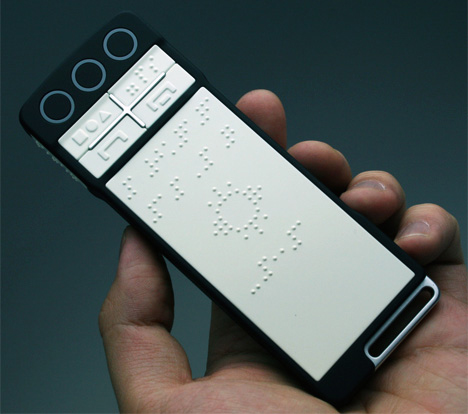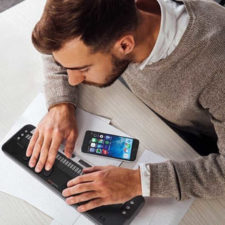Smart Glasses for the Visually Impaired: Innovations in Vision Support
Smart Glasses for the Visually Impaired: Innovations in Vision Support
Blog Article
Discover Innovative Devices Designed for the Visually Damaged
The advancement of ingenious tools for the visually damaged stands for a substantial innovation in access and freedom. Technologies such as clever glasses with AI capabilities and mobile applications made to offer acoustic summaries are reshaping everyday experiences for customers. Additionally, wearable gadgets that use haptic comments improve environmental recognition, while modern Braille advancements supply new methods to involve with message. As these devices continue to develop, their effect on the lives of those with aesthetic impairments elevates important concerns regarding the future of inclusivity and freedom in various facets of life. What exists in advance in this technical landscape?
Smart Glasses for Navigating

Smart glasses developed for navigating are transforming the means visually damaged people interact with their setting. These sophisticated devices make use of a mix of video camera technology, expert system, and auditory feedback to give real-time info about environments. By utilizing obstacle discovery systems, smart glasses can signal individuals to potential threats, allowing safer flexibility in both acquainted and unfamiliar settings.
The assimilation of GPS innovation further boosts navigation capacities, enabling customers to receive auditory directions as they relocate. This hands-free strategy not only cultivates independence however likewise empowers visually damaged individuals to navigate urban landscapes with increased self-confidence. In addition, numerous smart glasses are outfitted with functions that identify sites and street indications, providing contextual details that enhances the customer experience.
Additionally, the development of these tools is continuously advancing, with business functioning to boost the precision of object acknowledgment and increase the series of navigational attributes. As wise glasses end up being extra obtainable and inexpensive, they hold the potential to substantially transform every day life for aesthetically damaged customers. Inevitably, these ingenious devices stand for a critical step toward inclusivity, offering improved wheelchair and a better feeling of freedom for people navigating the globe around them.

Mobile Apps for Daily Living
How can mobile applications improve the day-to-days live of aesthetically damaged people? Mobile applications are changing the means visually damaged users navigate their environments, handle day-to-day tasks, and accessibility information. These applications supply crucial assistance via various functionalities, fostering independence and improving lifestyle.
Numerous cutting-edge mobile applications are made specifically for everyday living. For example, applications like Be My Eyes link visually impaired individuals with sighted volunteers by means of video clip telephone calls, permitting them to obtain real-time aid with jobs such as reading labels or navigating unfamiliar spaces. Seeing AI, developed by Microsoft, uses artificial knowledge to explain surroundings, reviewed message, and determine things, successfully transforming a smart device into an effective tool for daily help.
Additionally, navigating apps customized for the aesthetically impaired, such as Aira and BlindSquare, provide audio-based directions and ecological info, enabling customers to traverse their surroundings securely and with confidence. Beyond navigating and immediate help, mobile applications also sustain organization and task monitoring, with features that assist customers set tips, create to-do listings, and track consultations. In summary, mobile applications work as indispensable sources, empowering aesthetically impaired individuals to lead even more independent and fulfilling lives.
Wearable Technologies for Aid
Empowerment through innovation is significantly evident in the realm of wearable gadgets made to assist visually damaged people. These cutting-edge tools go to my site integrate effortlessly right into everyday life, boosting navigation and giving vital responses to customers. As an example, wise glasses outfitted with video cameras can recognize faces and check out text aloud, enabling individuals to connect even more with confidence in social and professional settings.
One more notable development is using haptic responses systems in wearable devices. These systems use resonances or various other responsive signals to share details regarding the customer's atmosphere, such as barriers or changes in surface, enhancing flexibility and safety. Wearable technologies likewise include wristbands that connect to smartphones, informing customers to alerts via refined resonances, hence boosting connection without dependence on visual cues.
As these technologies remain to evolve, they are not only boosting self-reliance for visually damaged imp source people but likewise promoting a greater feeling of inclusion in society. By linking the void in between difficulties dealt with in daily living and the possibility for autonomy, wearable innovations serve as pivotal devices in the mission for equality and empowerment for those with aesthetic disabilities.
Audio Summary Tools
Sound description devices play an important role in improving ease of access for aesthetically impaired individuals, giving them with the ability to involve with visual media. Braille displays and notetakers. These devices supply narrated summaries of essential aesthetic aspects in movies, television shows, and live efficiencies, making certain that individuals can completely understand the context and emotions communicated via visuals
Audio description can be incorporated right into various systems, including streaming services, movie theater screenings, and live cinema. Lots of popular streaming services currently include audio summary as an access attribute, enabling audiences to pick it quickly. In addition to conventional media, specialized applications additionally exist, supplying audio descriptions for art events, galleries, and other cultural occasions.
The effectiveness of audio description depends upon the skill of the storytellers, who need to convey visual information succinctly without diminishing the original audio. Innovations in this field are likewise leading the way for more personalized experiences, where users can change the degree of information and pacing according to their preferences.
Braille Innovations and Devices
Braille devices and advancements have actually considerably changed the means aesthetically impaired individuals connect with text and info. Modern innovations have actually led to the advancement of flexible tools that improve literacy and independence amongst customers.
Moreover, mobile Braille notetakers incorporate standard Braille input with contemporary performances, assisting in note-taking, organizing, and document editing on the go. Assistive technology for the blind. These compact devices frequently feature text-to-speech abilities, bridging the gap between Braille and auditory info
Furthermore, innovative Braille printers have arised, permitting customers to create Braille labels, files, and educational materials successfully. This accessibility cultivates better involvement in academic and professional atmospheres, eventually promoting Related Site inclusivity.
In addition, study right into wise Braille technologies proceeds to increase. Tools that integrate expert system are being discovered to offer real-time navigation aid and contextual details, improving the user experience in varied setups. In general, these advancements mirror a dedication to empowering visually damaged individuals through modern technology, guaranteeing they can easily access and involve with the world around them.

Conclusion
The improvement of cutting-edge devices for the aesthetically damaged dramatically boosts freedom and top quality of life. Smart glasses, mobile applications, wearable modern technologies, audio summary devices, and Braille technologies jointly equip individuals by supplying vital navigating aid, ecological recognition, and improved reading experiences. These technologies not just foster better incorporation but also promote autonomy in day-to-day tasks, eventually contributing to a much more equitable and obtainable culture for visually impaired individuals. Proceeded advancement in this area holds pledge for additional enhancements.
As smart glasses come to be much more budget-friendly and accessible, they hold the prospective to dramatically transform everyday life for visually impaired individuals. Mobile apps are transforming the means visually impaired customers navigate their atmospheres, manage day-to-day jobs, and gain access to details. Apps like Be My Eyes connect aesthetically impaired customers with sighted volunteers by means of video clip phone calls, permitting them to get real-time assistance with jobs such as reviewing labels or browsing strange spaces.Furthermore, navigating apps tailored for the aesthetically damaged, such as Aira and BlindSquare, offer audio-based directions and ecological details, allowing users to traverse their environments safely and confidently.The development of cutting-edge tools for the visually damaged considerably enhances independence and high quality of life.
Report this page